You Li
NRCIEA
Think in Safety: Unveiling and Mitigating Safety Alignment Collapse in Multimodal Large Reasoning Model
May 10, 2025Abstract:The rapid development of multimodal large reasoning models (MLRMs) has demonstrated broad application potential, yet their safety and reliability remain critical concerns that require systematic exploration. To address this gap, we conduct a comprehensive and systematic safety evaluation of 11 MLRMs across 5 benchmarks and unveil prevalent safety degradation phenomena in most advanced models. Moreover, our analysis reveals distinct safety patterns across different benchmarks: significant safety degradation is observed across jailbreak robustness benchmarks, whereas safety-awareness benchmarks demonstrate less pronounced degradation. In particular, a long thought process in some scenarios even enhances safety performance. Therefore, it is a potential approach to addressing safety issues in MLRMs by leveraging the intrinsic reasoning capabilities of the model to detect unsafe intent. To operationalize this insight, we construct a multimodal tuning dataset that incorporates a safety-oriented thought process. Experimental results from fine-tuning existing MLRMs with this dataset effectively enhances the safety on both jailbreak robustness and safety-awareness benchmarks. This study provides a new perspective for developing safe MLRMs. Our dataset is available at https://github.com/xinyuelou/Think-in-Safety.
HSS-IAD: A Heterogeneous Same-Sort Industrial Anomaly Detection Dataset
Apr 17, 2025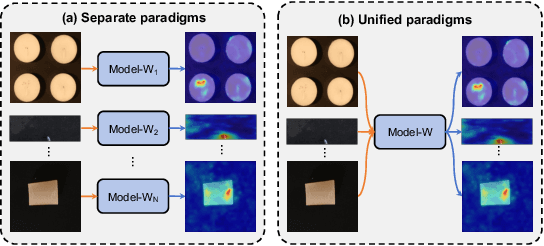
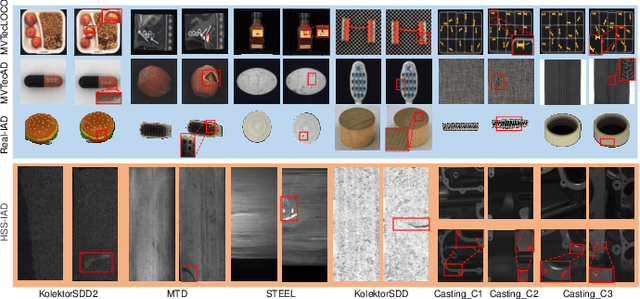


Abstract:Multi-class Unsupervised Anomaly Detection algorithms (MUAD) are receiving increasing attention due to their relatively low deployment costs and improved training efficiency. However, the real-world effectiveness of MUAD methods is questioned due to limitations in current Industrial Anomaly Detection (IAD) datasets. These datasets contain numerous classes that are unlikely to be produced by the same factory and fail to cover multiple structures or appearances. Additionally, the defects do not reflect real-world characteristics. Therefore, we introduce the Heterogeneous Same-Sort Industrial Anomaly Detection (HSS-IAD) dataset, which contains 8,580 images of metallic-like industrial parts and precise anomaly annotations. These parts exhibit variations in structure and appearance, with subtle defects that closely resemble the base materials. We also provide foreground images for synthetic anomaly generation. Finally, we evaluate popular IAD methods on this dataset under multi-class and class-separated settings, demonstrating its potential to bridge the gap between existing datasets and real factory conditions. The dataset is available at https://github.com/Qiqigeww/HSS-IAD-Dataset.
OmniGeo: Towards a Multimodal Large Language Models for Geospatial Artificial Intelligence
Mar 20, 2025Abstract:The rapid advancement of multimodal large language models (LLMs) has opened new frontiers in artificial intelligence, enabling the integration of diverse large-scale data types such as text, images, and spatial information. In this paper, we explore the potential of multimodal LLMs (MLLM) for geospatial artificial intelligence (GeoAI), a field that leverages spatial data to address challenges in domains including Geospatial Semantics, Health Geography, Urban Geography, Urban Perception, and Remote Sensing. We propose a MLLM (OmniGeo) tailored to geospatial applications, capable of processing and analyzing heterogeneous data sources, including satellite imagery, geospatial metadata, and textual descriptions. By combining the strengths of natural language understanding and spatial reasoning, our model enhances the ability of instruction following and the accuracy of GeoAI systems. Results demonstrate that our model outperforms task-specific models and existing LLMs on diverse geospatial tasks, effectively addressing the multimodality nature while achieving competitive results on the zero-shot geospatial tasks. Our code will be released after publication.
Migician: Revealing the Magic of Free-Form Multi-Image Grounding in Multimodal Large Language Models
Jan 13, 2025



Abstract:The recent advancement of Multimodal Large Language Models (MLLMs) has significantly improved their fine-grained perception of single images and general comprehension across multiple images. However, existing MLLMs still face challenges in achieving precise grounding in complex multi-image scenarios. To address this, we first explore a Chain-of-Thought (CoT) framework that integrates single-image grounding with multi-image comprehension. While partially effective, it remains unstable and struggles to capture abstract visual information due to its non-end-to-end nature. Therefore, we introduce Migician, the first multi-image grounding model capable of performing free-form and accurate grounding across multiple images. To support this, we present the MGrounding-630k dataset, which comprises data for several multi-image grounding tasks derived from existing datasets, along with newly generated free-form grounding instruction-following data. Furthermore, we propose MIG-Bench, a comprehensive benchmark specifically designed for evaluating multi-image grounding capabilities. Experimental results demonstrate that our model achieves significantly superior multi-image grounding capabilities, outperforming the best existing MLLMs by 21.61% and even surpassing much larger 70B models. Our code, model, dataset, and benchmark are fully open-sourced at https://migician-vg.github.io/.
A Real-time Degeneracy Sensing and Compensation Method for Enhanced LiDAR SLAM
Dec 10, 2024



Abstract:LiDAR is widely used in Simultaneous Localization and Mapping (SLAM) and autonomous driving. The LiDAR odometry is of great importance in multi-sensor fusion. However, in some unstructured environments, the point cloud registration cannot constrain the poses of the LiDAR due to its sparse geometric features, which leads to the degeneracy of multi-sensor fusion accuracy. To address this problem, we propose a novel real-time approach to sense and compensate for the degeneracy of LiDAR. Firstly, this paper introduces the degeneracy factor with clear meaning, which can measure the degeneracy of LiDAR. Then, the Density-Based Spatial Clustering of Applications with Noise (DBSCAN) clustering method adaptively perceives the degeneracy with better environmental generalization. Finally, the degeneracy perception results are utilized to fuse LiDAR and IMU, thus effectively resisting degeneracy effects. Experiments on our dataset show the method's high accuracy and robustness and validate our algorithm's adaptability to different environments and LiDAR scanning modalities.
AC-LIO: Towards Asymptotic and Consistent Convergence in LiDAR-Inertial Odometry
Dec 08, 2024



Abstract:Existing LiDAR-Inertial Odometry (LIO) frameworks typically utilize prior state trajectories derived from IMU integration to compensate for the motion distortion within LiDAR frames, and demonstrate outstanding accuracy and stability in regular low-speed and smooth scenes. However, in high-speed or intense motion scenarios, the residual distortion may increase due to the limitation of IMU's accuracy and frequency, which will degrade the consistency between the LiDAR frame with its represented geometric environment, leading pointcloud registration to fall into local optima and consequently increasing the drift in long-time and large-scale localization. To address the issue, we propose a novel asymptotically and consistently converging LIO framework called AC-LIO. First, during the iterative state estimation, we backwards propagate the update term based on the prior state chain, and asymptotically compensate the residual distortion before next iteration. Second, considering the weak correlation between the initial error and motion distortion of current frame, we propose a convergence criteria based on pointcloud constraints to control the back propagation. The approach of guiding the asymptotic distortion compensation based on convergence criteria can promote the consistent convergence of pointcloud registration and increase the accuracy and robustness of LIO. Experiments show that our AC-LIO framework, compared to other state-of-the-art frameworks, effectively promotes consistent convergence in state estimation and further improves the accuracy of long-time and large-scale localization and mapping.
AnySynth: Harnessing the Power of Image Synthetic Data Generation for Generalized Vision-Language Tasks
Nov 24, 2024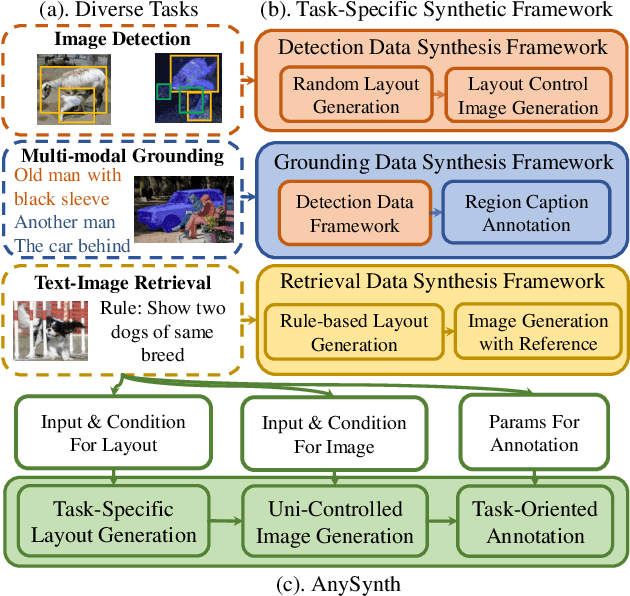

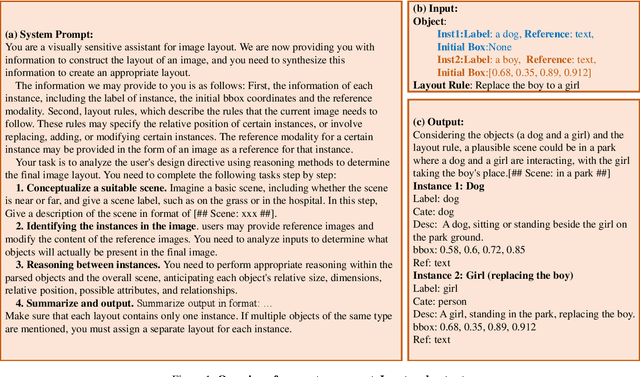
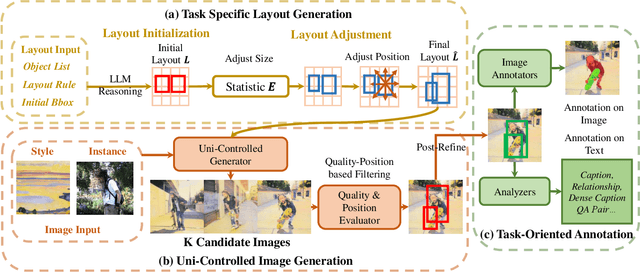
Abstract:Diffusion models have recently been employed to generate high-quality images, reducing the need for manual data collection and improving model generalization in tasks such as object detection, instance segmentation, and image perception. However, the synthetic framework is usually designed with meticulous human effort for each task due to various requirements on image layout, content, and annotation formats, restricting the application of synthetic data on more general scenarios. In this paper, we propose AnySynth, a unified framework integrating adaptable, comprehensive, and highly controllable components capable of generating an arbitrary type of synthetic data given diverse requirements. Specifically, the Task-Specific Layout Generation Module is first introduced to produce reasonable layouts for different tasks by leveraging the generation ability of large language models and layout priors of real-world images. A Uni-Controlled Image Generation Module is then developed to create high-quality synthetic images that are controllable and based on the generated layouts. In addition, user specific reference images, and style images can be incorporated into the generation to task requirements. Finally, the Task-Oriented Annotation Module offers precise and detailed annotations for the generated images across different tasks. We have validated our framework's performance across various tasks, including Few-shot Object Detection, Cross-domain Object Detection, Zero-shot Composed Image Retrieval, and Multi-modal Image Perception and Grounding. The specific data synthesized by our framework significantly improves model performance in these tasks, demonstrating the generality and effectiveness of our framework.
Imagine and Seek: Improving Composed Image Retrieval with an Imagined Proxy
Nov 24, 2024



Abstract:The Zero-shot Composed Image Retrieval (ZSCIR) requires retrieving images that match the query image and the relative captions. Current methods focus on projecting the query image into the text feature space, subsequently combining them with features of query texts for retrieval. However, retrieving images only with the text features cannot guarantee detailed alignment due to the natural gap between images and text. In this paper, we introduce Imagined Proxy for CIR (IP-CIR), a training-free method that creates a proxy image aligned with the query image and text description, enhancing query representation in the retrieval process. We first leverage the large language model's generalization capability to generate an image layout, and then apply both the query text and image for conditional generation. The robust query features are enhanced by merging the proxy image, query image, and text semantic perturbation. Our newly proposed balancing metric integrates text-based and proxy retrieval similarities, allowing for more accurate retrieval of the target image while incorporating image-side information into the process. Experiments on three public datasets demonstrate that our method significantly improves retrieval performances. We achieve state-of-the-art (SOTA) results on the CIRR dataset with a Recall@K of 70.07 at K=10. Additionally, we achieved an improvement in Recall@10 on the FashionIQ dataset, rising from 45.11 to 45.74, and improved the baseline performance in CIRCO with a mAPK@10 score, increasing from 32.24 to 34.26.
Knowledge-Guided Dynamic Modality Attention Fusion Framework for Multimodal Sentiment Analysis
Oct 06, 2024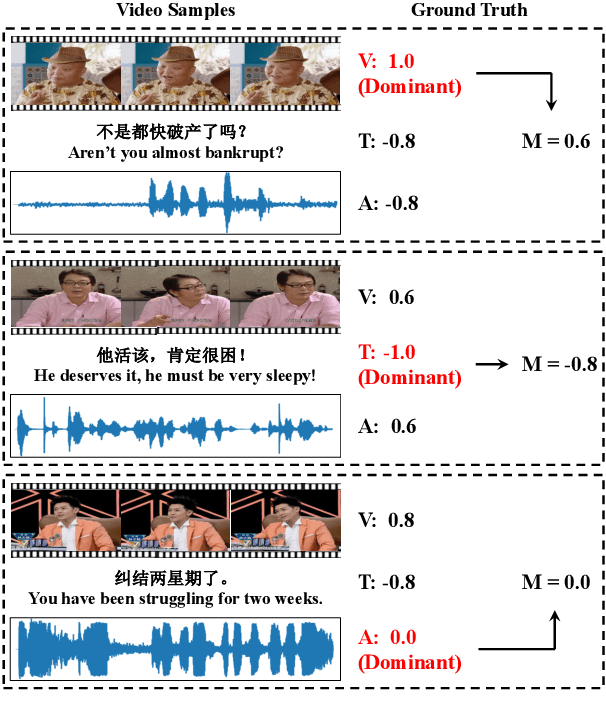

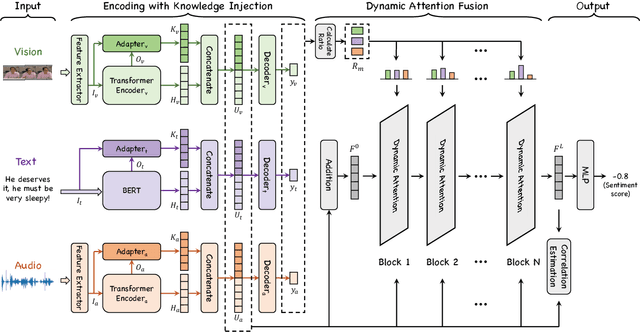
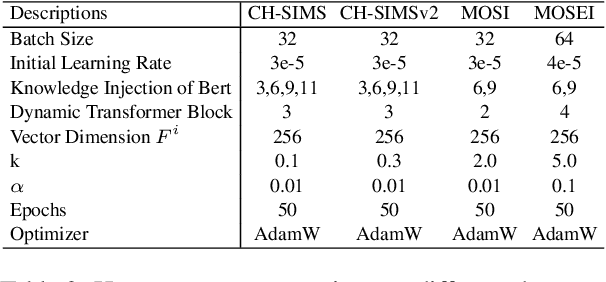
Abstract:Multimodal Sentiment Analysis (MSA) utilizes multimodal data to infer the users' sentiment. Previous methods focus on equally treating the contribution of each modality or statically using text as the dominant modality to conduct interaction, which neglects the situation where each modality may become dominant. In this paper, we propose a Knowledge-Guided Dynamic Modality Attention Fusion Framework (KuDA) for multimodal sentiment analysis. KuDA uses sentiment knowledge to guide the model dynamically selecting the dominant modality and adjusting the contributions of each modality. In addition, with the obtained multimodal representation, the model can further highlight the contribution of dominant modality through the correlation evaluation loss. Extensive experiments on four MSA benchmark datasets indicate that KuDA achieves state-of-the-art performance and is able to adapt to different scenarios of dominant modality.
AS-LIO: Spatial Overlap Guided Adaptive Sliding Window LiDAR-Inertial Odometry for Aggressive FOV Variation
Aug 21, 2024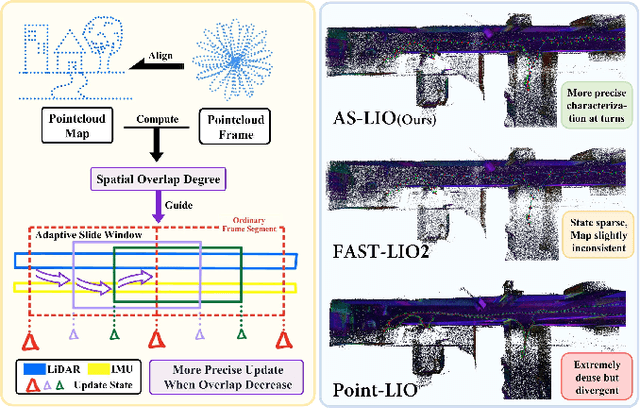
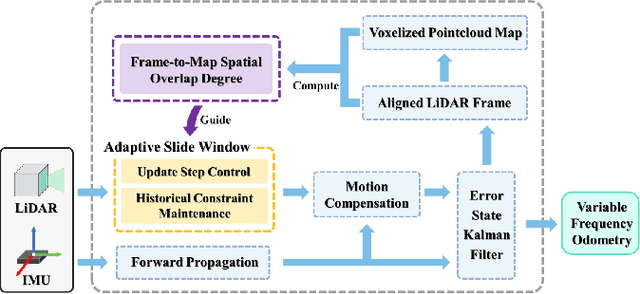
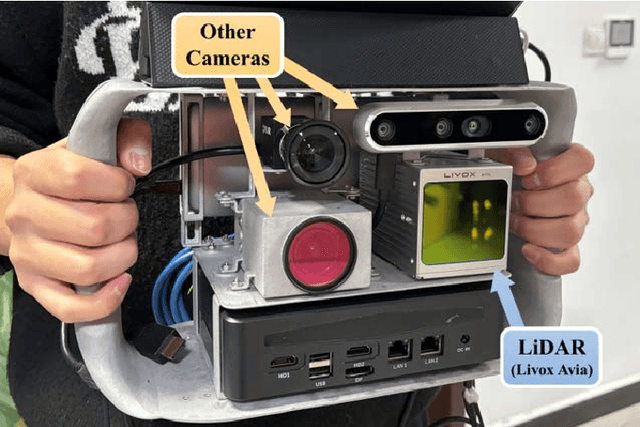
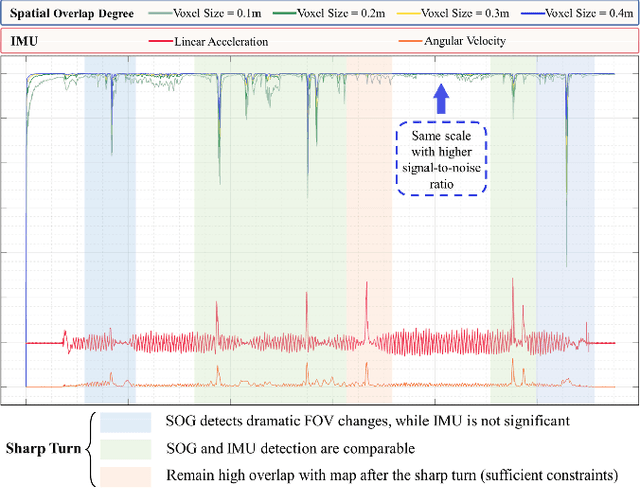
Abstract:LiDAR-Inertial Odometry (LIO) demonstrates outstanding accuracy and stability in general low-speed and smooth motion scenarios. However, in high-speed and intense motion scenarios, such as sharp turns, two primary challenges arise: firstly, due to the limitations of IMU frequency, the error in estimating significantly non-linear motion states escalates; secondly, drastic changes in the Field of View (FOV) may diminish the spatial overlap between LiDAR frame and pointcloud map (or between frames), leading to insufficient data association and constraint degradation. To address these issues, we propose a novel Adaptive Sliding window LIO framework (AS-LIO) guided by the Spatial Overlap Degree (SOD). Initially, we assess the SOD between the LiDAR frames and the registered map, directly evaluating the adverse impact of current FOV variation on pointcloud alignment. Subsequently, we design an adaptive sliding window to manage the continuous LiDAR stream and control state updates, dynamically adjusting the update step according to the SOD. This strategy enables our odometry to adaptively adopt higher update frequency to precisely characterize trajectory during aggressive FOV variation, thus effectively reducing the non-linear error in positioning. Meanwhile, the historical constraints within the sliding window reinforce the frame-to-map data association, ensuring the robustness of state estimation. Experiments show that our AS-LIO framework can quickly perceive and respond to challenging FOV change, outperforming other state-of-the-art LIO frameworks in terms of accuracy and robustness.
 Add to Chrome
Add to Chrome Add to Firefox
Add to Firefox Add to Edge
Add to Edge